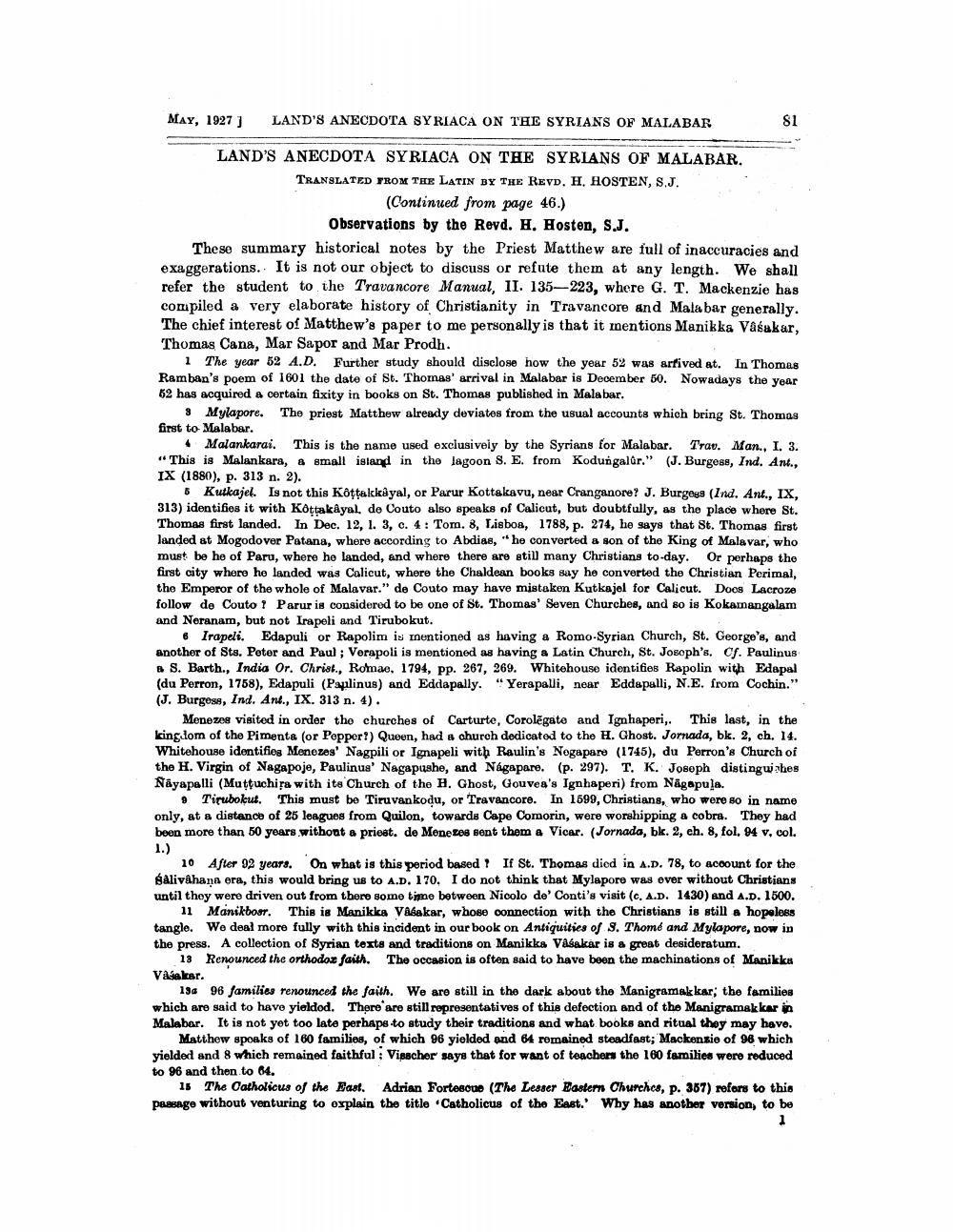________________
MAY, 1927)
LAND'S ANECDOTA SYRIACA ON THE SYRIANS OF MALABAR
$1
LAND'S ANECDOTA SYRIACA ON THE SYRIANS OF MALABAR. TRANSLATED FROM THE LATIN BY THE REVD. H. HOSTEN, S.J.
(Continued from page 46.)
Observations by the Revd. H. Hosten, S.J. These summary historical notes by the Priest Matthew are full of inaccuracies and exaggerations. It is not our object to discuss or refute them at any length. We shall refer the student to the Travancore Manual, II. 135—223, where G. T. Mackenzie has compiled a very elaborate history of Christianity in Travancore and Malabar generally. The chief interest of Matthew's paper to me personally is that it mentions Manikka Vásukar, Thomas Cana, Mar Sapor and Mar Prodh.
1 The year 52 A.D. Further study should disclose how the year 52 was arrived at. In Thomas Ramban's poem of 1601 the date of St. Thomas' arrival in Malabar is December 60. Nowadays the year 62 has acquired a certain fixity in books on St. Thomas published in Malabar.
9 Mylapore. The priest Matthew already deviates from the usual accounts which bring St. Thomas first to Malabar.
4 Malankarai. This is the name used exclusively by the Syrians for Malabar. Trav. Man., I. 3. “This is Malankara, A small island in the lagoon S. E. from Kodungalar." (J. Burgess, Ind. Ant., IX (1880), p. 313 n. 2).
6 Kutkajel. Is not this Kottakkůyal, or Parur Kottakavu, near Cranganore? J. Burgess (Ind. Ant., IX, 313) identifies it with Kottakayal, do Couto also speaks of Calicut, but doubtfully, as the place where St. Thomas first landed. In Dec. 12, 1. 3, c. 4: Tom. 8, Lisboa, 1788, p. 274, he says that St. Thomas first landed at Mogodover Patana, where according to Abdias, "he converted a son of the King of Malavar, who must be he of Paru, where he landed, and where there are still many Christians to-day. Or perhaps the first city where he landed was Calicut, where the Chaldean books say he converted the Christian Perimal, the Emperor of the whole of Malavar." de Couto may have mistaken Kutkajel for Calicut. Doos Lacroze follow de Couto 1 Parur is considered to be one of St. Thomas' Seven Churches, and so is Kokarnangalam and Neranam, but not Irapeli and Tirubokut.
6 Irapeli. Edapuli or Rapolim is mentioned as having a Romo-Syrian Church, St. George's, and another of Sts. Peter and Paul ; Verapoli is mentioned as having a Latin Church, St. Josoph's. Cf. Paulinus & S. Barth., India Or. Christ., Romae, 1794, pp. 267, 269. Whitehouse identifies Rapolin with Edapal (du Perron, 1758), Edapuli (Psplinus) and Eddapally. "Yerapalli, near Eddapalli, N.E. from Cochin." (J. Burgess, Ind. Ant., IX. 313 n. 4).
Menezes visited in order the churches of Carturte, Corolēgate and Ignhaperi,. This last, in the kingitom of the Pimenta (or Poppor) Queen, had a church dedicated to the H. Ghost. Jornada, bk. 2, ch. 14. Whitehouse identifies Menezes' Nagpili or Ignapeli with Raulin's Nogapare (1745), du Perron's Church of the H. Virgin of Nagapoje, Paulinus' Nagapushe, and Nagapare. (p. 297). T. K. Joseph distinguahes Nāyapalli (Muttuchira with its Church of the H. Ghost, Gouvea's Ignhaperi) from Nāgapula.
9 Tirubokut. This must be Tiruvankodu, or Travancore. In 1599, Christians, who were so in name only, at a distance of 25 leagues from Quilon, towards Cape Comorin, were worshipping a cobra. They had been more than 50 years without a priest. de Menezes sent them a Vicar. (Jornada, bk. 2, eh. 8, fol. 94 v, col. 1.)
10 After 92 years. On what is this period based! If St. Thomas diod in A.D. 78, to scoount for the Alivihana era, this would bring us to A.D. 170. I do not think that Mylapore was ever without Christians until they were driven out from there some time between Nicolo de' Conti's visit (c. A.D. 1430) and A.D. 1500.
11 Manikboer. This is Manikka VAbakar, whose connection with the Christians is still a hopeless tangle. We deal more fully with this incident in our book on Antiquities of S. Thomé and Mylapore, now in the press. A collection of Syrian texts and traditions on Manikka Vasakar is a great desideratum.
13 Renounced the orthodox faith. The occasion is often said to have been the machinations of Manikka Våsaker.
134 96 families renounced the faith. We are still in the dark about the Manigramakkar; the families which are said to have yieldod. There are still representatives of this defection and of the Manigramakkar in Malabar. It is not yet too late perhaps to study their traditions and what books and ritual they may have.
Matthew spoaks of 160 families, of which 96 yielded and 64 romained steadfast; Mackensie of 96 which yielded and 8 which remained faithful : Visscher says that for want of teachers the 160 families were reduced to 96 and then to 64.
15 The Catholicus of the East. Adrian Fortesobe (The Lesser Eastern Churches, p. 367) refers to this passage without venturing to explain the title Catholicus of the East. Why has another version, to be




